Qualitative and Quantitative Factors in Fundamental Analysis
أهداف التعلم الرئيسية:
مقدمة: This chapter focuses on understanding key qualitative و quantitative factors in fundamental analysis. These factors are essential in evaluating a company’s potential as an investment, enabling you to make more informed stock selection decisions.
- تعريف and understand the significance of various qualitative factors like Management Quality, Industry Growth, and Innovation in assessing a company’s competitive advantage.
- يتعلم about different quantitative factors including Profit Margins, Cash Flow, and Earnings Growth, which are crucial in evaluating a company’s financial performance.
- يستكشف the methods of Fundamental Analysis, such as Top-Down و تصاعدي approaches, and how they incorporate both qualitative and quantitative factors.
مقدمة:
In this chapter, we’ll explore seven key qualitative and quantitative factors that play a significant role in evaluating a company’s potential as an investment. Understanding these factors can help you make more informed decisions when selecting stocks.
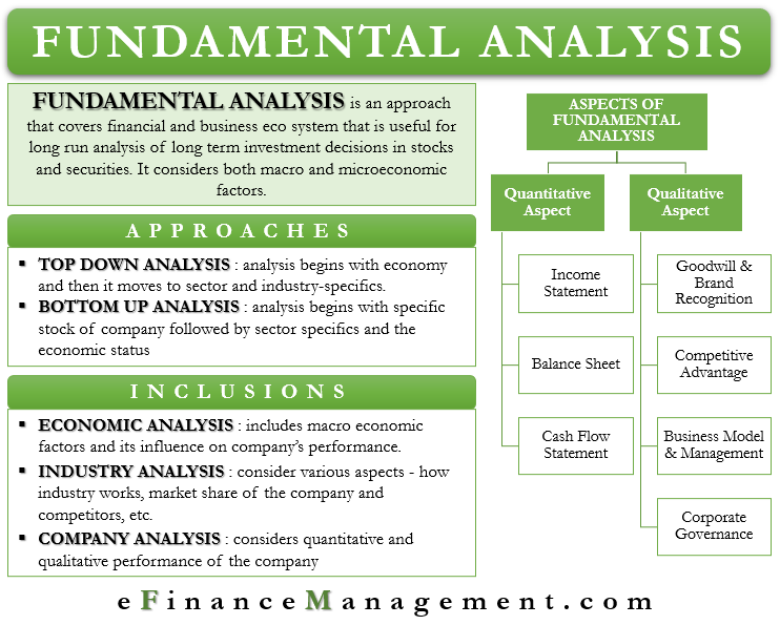
عنوان الشكل: Components of Fundamental Analysis
مصدر: إدارة التمويل الإلكتروني
وصف: The figure provides a comprehensive look at fundamental analysis, a method used to evaluate the intrinsic value of a stock. It breaks down the analysis into two primary approaches: top-down and bottom-up. It also highlights both quantitative factors, like financial statements, and qualitative factors, like brand recognition and management quality.
الماخذ الرئيسية:
- Top-Down vs Bottom-Up Analysis: ‘Top-Down’ starts by analyzing the macroeconomic environment and moves to individual stocks, while ‘Bottom-Up’ starts with specific companies and then looks at the broader economic conditions.
- Quantitative Factors: These include financial statements like the income statement, balance sheet, and cash flow statement which offer insights into the company’s financial health.
- Qualitative Factors: These include elements like brand recognition, management quality, and corporate governance that may not be reflected in the financials but are crucial for a company’s success.
طلب: Fundamental analysis is vital for long-term investment strategies. It provides a holistic view of a company’s health, combining both quantitative and qualitative measures. Investors can use this information to make more informed decisions about a stock’s true value and growth potential.
20.1 Qualitative Factors:
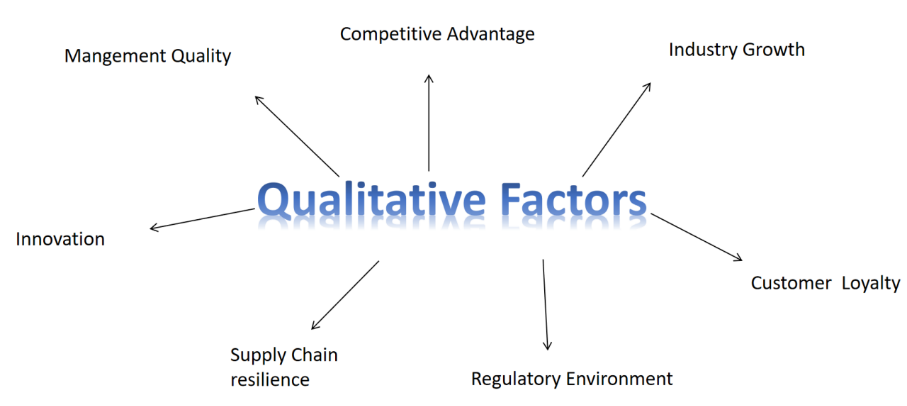
عنوان الشكل: Qualitative Factors Influencing Competitive Advantage
المصدر: رسم بياني مخصص
وصف: The image showcases various qualitative factors that play a pivotal role in determining a company’s competitive advantage. These factors include Management Quality, Industry Growth, Innovation, Customer Loyalty, Supply Chain Resilience, and the Regulatory Environment. Each of these elements contributes to the overall strength and positioning of a company within its industry.
الماخذ الرئيسية:
- Management Quality: The expertise, experience, and effectiveness of a company’s leadership team.
- Industry Growth: The potential for expansion and profitability within the industry.
- Innovation: The company’s ability to introduce new products, services, or processes.
- Customer Loyalty: The degree to which customers remain committed to a company’s products or services.
- Supply Chain Resilience: The robustness of a company’s supply chain to withstand disruptions.
- Regulatory Environment: The impact of governmental regulations on a company’s operations.
طلب: Understanding these qualitative factors is essential for investors and stakeholders to gauge a company’s potential for sustained competitive advantage. A firm that excels in these areas is likely to be more resilient to market challenges, adapt to changing industry dynamics, and maintain a strong position in its market segment. By focusing on these qualitative aspects, investors can make more informed decisions about the long-term viability and growth potential of a company.
- Management Quality: A strong management team can drive a company’s success. Look for experienced executives with a track record of delivering results, effective communication skills, and a clear vision for the company’s future.
- Competitive Advantage: Companies with a sustainable competitive advantage, such as proprietary technology or a strong brand, are more likely to outperform their peers. Examine the company’s unique strengths and how they set it apart from competitors.
- Industry Growth: A growing industry offers more opportunities for companies to expand and increase revenues. Consider the overall health and growth prospects of the industry in which the company operates.
- Customer Loyalty: Companies with a loyal customer base are more likely to have stable revenues and lower marketing costs. Assess the company’s reputation, customer satisfaction levels, and brand strength.
- Regulatory Environment: Companies facing significant regulatory challenges may struggle to grow or maintain profitability. Understand the regulations affecting the company and their potential impact on operations and growth.
- Supply Chain Resilience: A robust and diversified supply chain can help a company navigate disruptions and maintain consistent operations. Evaluate the company’s supplier relationships, geographic diversification, and reliance on key suppliers.
- Innovation: Companies that continually innovate and adapt to changing market conditions are better positioned for long-term success. Look for evidence of research and development, product pipeline, and a culture of innovation.
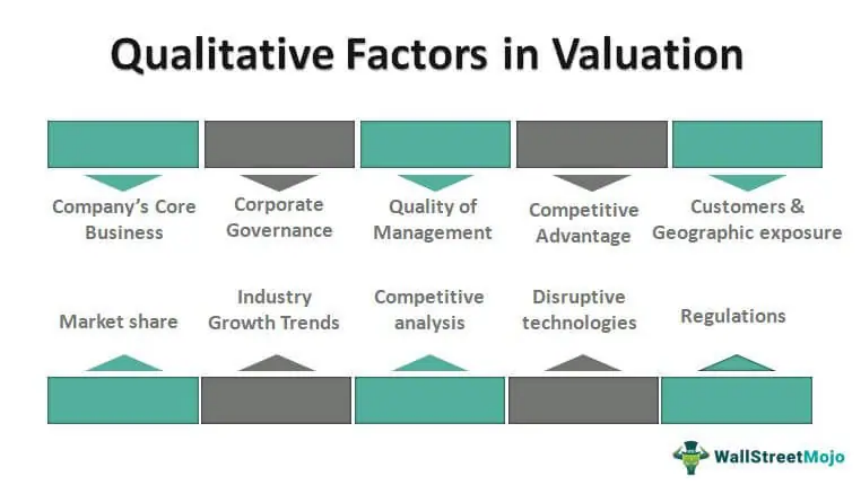
عنوان الشكل: Qualitative Factors in Valuation
مصدر: وول ستريت موجو
وصف: This figure presents various qualitative factors that investors should consider while valuing a company. These factors range from the core business of the company to the quality of its management and its market share.
الماخذ الرئيسية:
- Company Core Business: Investors should understand what the company actually does and how it generates its revenue.
- Quality of Management: The skills, experience, and track record of the management can significantly influence a company’s performance.
- Market Share and Industry Growth: These give an idea of the company’s competitive position within its industry and whether the industry itself is growing.
طلب: Qualitative factors add depth to your investment analysis. They help investors identify a company’s intangible strengths or weaknesses, which are not readily evident in the financial statements. Knowing these can help you make more comprehensive investment decisions.
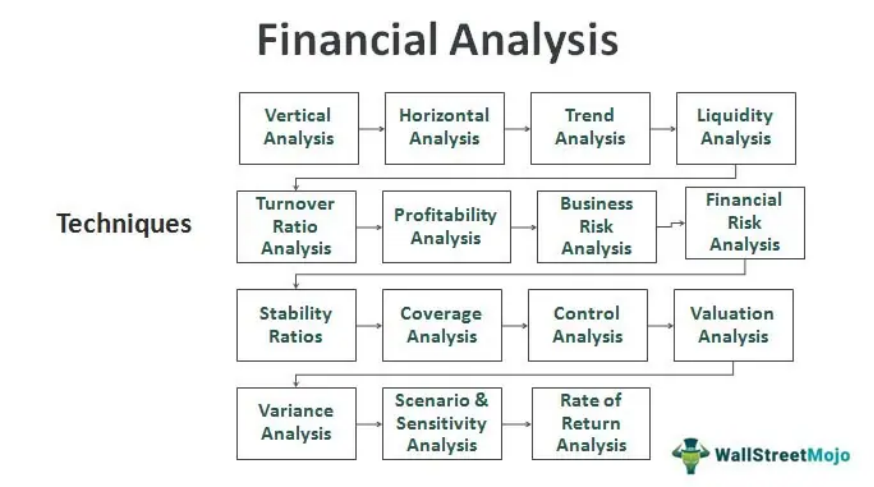
عنوان الشكل: Financial Analysis Techniques
مصدر: وول ستريت موجو
وصف: This figure lays out the various techniques used in financial analysis, from trend analysis and liquidity analysis to valuation and rate of return analysis.
الماخذ الرئيسية:
- Vertical and Horizontal Analysis: These techniques help to understand a company’s financial statements in detail, comparing items over time or against other line items.
- Liquidity Analysis and Turnover Ratio: These metrics tell us how easily a company can meet its short-term liabilities.
- Profitability Analysis: This helps to gauge how well a company is performing in terms of profit relative to its sales, assets, or equity.
طلب: These financial analysis techniques offer multiple lenses to evaluate a company’s health and performance. Knowing how to apply these techniques helps investors make informed decisions and diversify their investment strategies.
20.2 Quantitative Factors:
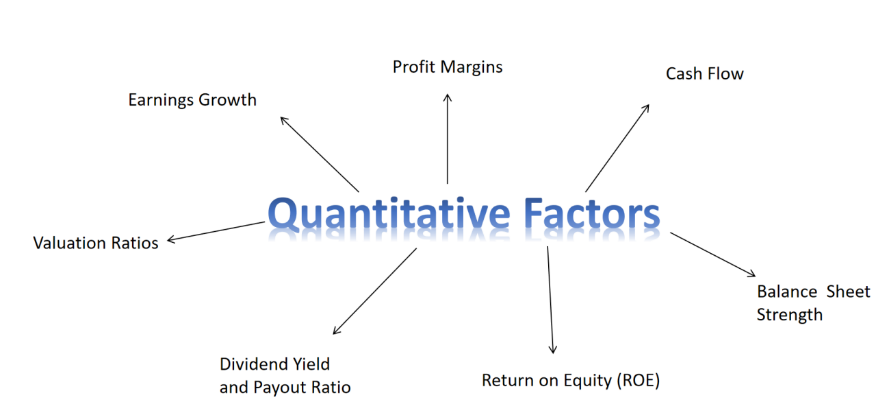
عنوان الشكل: Quantitative Factors Influencing Financial Performance
Source: Custom Infographics
وصف: The image highlights various quantitative factors that are pivotal in assessing a company’s financial performance. These factors encompass Profit Margins, Cash Flow, Earnings Growth, Valuation Ratios, Balance Sheet Strength, Dividend Yield and Payout Ratio, and Return on Equity (ROE). Each factor provides insights into the financial health, profitability, and overall performance of a company.
الماخذ الرئيسية:
- Profit Margins: Indicates the profitability of a company by showing the percentage of revenue that exceeds the costs.
- تدفق مالي: Represents the net amount of cash and cash equivalents moving in and out of a business.
- Earnings Growth: Measures the annual rate at which a company’s earnings are increasing.
- Valuation Ratios: Used to determine the relative value of a company’s stock.
- Balance Sheet Strength: Evaluates a company’s financial health by analyzing its assets, liabilities, and shareholders’ equity.
- Dividend Yield and Payout Ratio: Reflects the return on investment for a company’s shareholders.
- Return on Equity (ROE): Measures a company’s profitability by revealing how much profit it generates with the money shareholders have invested.
طلب: For investors and financial analysts, these quantitative factors are crucial in making informed investment decisions. A company that showcases strength in these areas is likely to have a solid financial foundation, making it a potentially good investment. By focusing on these quantitative metrics, investors can gauge the financial stability, growth potential, and overall health of a company, aiding in the decision-making process
- Earnings Growth: Consistent earnings growth is a sign of a company’s profitability and financial health. Review historical earnings growth rates and analyst projections for future growth.
- Profit Margins: High profit margins indicate a company’s ability to generate profits from its revenues. Compare the company’s margins with industry peers to assess its relative efficiency.
- تدفق مالي: Positive cash flow enables a company to reinvest in growth initiatives, pay down debt, or return capital to shareholders. Examine the company’s cash flow statement to understand its cash generation and usage.
- Balance Sheet Strength: A strong balance sheet, characterized by low debt and ample liquidity, indicates a company’s financial stability. Analyze the company’s debt-to-equity ratio, current ratio, and other balance sheet metrics.
- Return on Equity (ROE): ROE measures a company’s profitability relative to shareholder equity. A higher ROE suggests better efficiency in using shareholder capital to generate profits.
- Dividend Yield and Payout Ratio: For income-focused investors, the dividend yield and payout ratio can be important considerations. A higher dividend yield indicates more income generation, while a sustainable payout ratio suggests that dividends are well-covered by earnings.
- Valuation Ratios: Valuation ratios, such as price-to-earnings (P/E) and price-to-sales (P/S), help investors determine if a stock is over- or under-valued relative to its peers. Look for companies trading at attractive valuations based on these metrics.
By considering both qualitative and quantitative factors in your investment analysis, you can gain a comprehensive understanding of a company’s potential and make better-informed decisions when selecting stocks.
الماخذ الرئيسية:
كلمة الختام: Grasping the qualitative و quantitative factors in fundamental analysis is critical for long-term investment success. This knowledge provides a more holistic view of a company’s value, enabling better investment decisions.
- العوامل النوعية, such as Management Quality and Innovation, provide insights into a company’s intangible strengths that are not visible in financial statements but are crucial for its success.
- العوامل الكمية like Profit Margins and Earnings Growth give a measurable assessment of a company’s financial health and performance.
- ال Top-Down و تصاعدي approaches in Fundamental Analysis offer different perspectives on evaluating stocks, emphasizing the importance of a comprehensive analysis that includes both quantitative and qualitative aspects.
- فهم core business of a company and the quality of its management are essential in assessing its long-term viability and competitive position in the market.
- Financial analysis techniques such as liquidity analysis and profitability analysis are vital tools for evaluating a company’s financial condition and investment potential.

